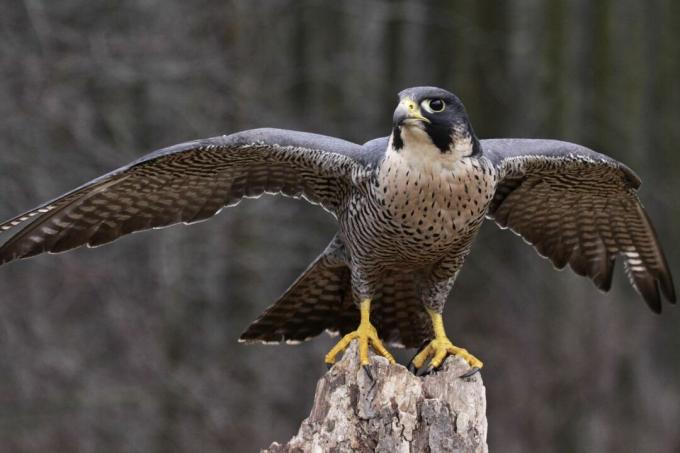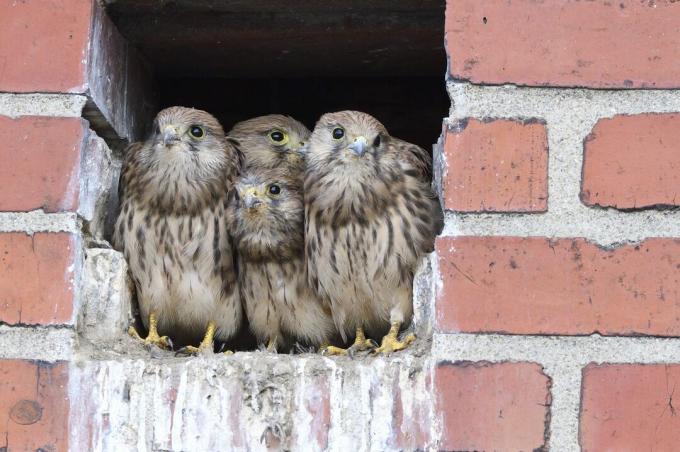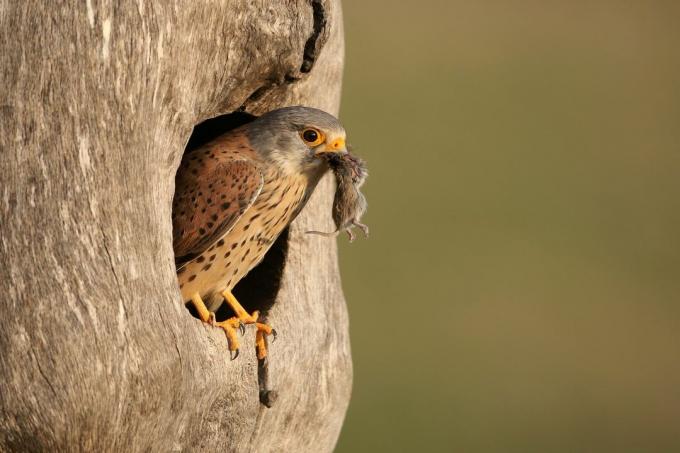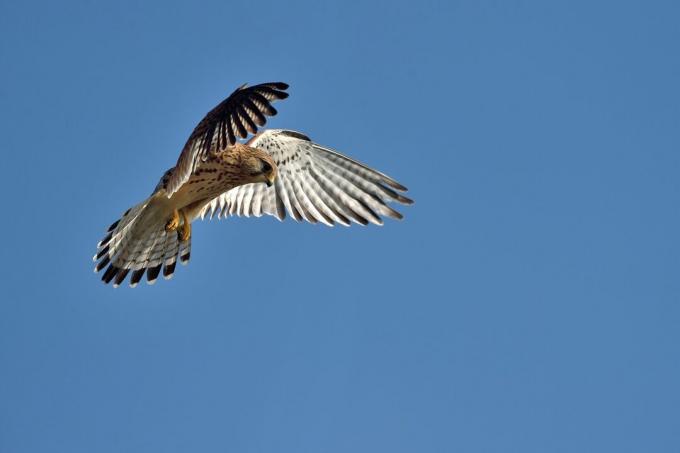What is the difference between the peregrine falcon and the kestrel? How do you recognize a young kestrel? And what does the bird of prey eat? We answer these and numerous other questions in our profile.

The kestrel (Falco tinnunculus) is by far the most common falcon in Central Europe and after Common buzzard also the second most common native bird of prey. As a cultural follower, the magnificent falcon is widespread in both settlements and cities, where it breeds in old, tall buildings. The best way to observe the kestrel is on the hunt when it presents its classic “shaking flight” - a Flight form in which the bird flaps its wings quickly while “standing” in the air in fields and meadows for prey seeks. More exciting facts about the “Bird of the Year 2007” can be found here in our large kestrel profile.
"Contents"
- Kestrel: wanted poster
-
This is how you recognize the kestrel
- What is the difference between female and male kestrels?
- What is the difference between the kestrel and the peregrine falcon?
- What does the kestrel call sound like?
- What do kestrel eggs look like?
- How do you recognize a young kestrel?
- Which habitat does the kestrel prefer?
- Where does the kestrel have its nest?
- Where does the kestrel spend the winter?
- What do kestrels eat?
-
Support the kestrel: that's how it works
- Which nest boxes are suitable for kestrels?
- How can you give the kestrel additional support?
Kestrel: wanted poster
| size | 31 - 37 cm |
| weight | About 200 g |
| Breeding season | April May |
| lifespan | Up to 18 years |
| habitat | Open and semi-open landscapes, settlements and cities |
| Feed preference | Voles, field mice and other small animals |
| Threats | Decline in food and nesting sites |
This is how you recognize the kestrel
The kestrel is about the size of a pigeon, but is a lot slimmer and more elegant than one, for example Wood pigeon. The backs and the base of the wings of the birds are of a rich reddish brown, which merges into a dark black-gray towards the wing tips. The chest and belly are lighter, but like the back and wings, they are streaked with dark, strong spots. The face of the birds of prey is characterized by a dark streak of beard and yellow circles under the eyes.
In flight, the kestrel can also be recognized by its shaking flight pattern and its narrow wings, which distinguish it from the sparrowhawk, for example. Kestrels have a wingspan of around 75 cm and reach a speed of around 60 km / h.

What is the difference between female and male kestrels?
As is often the case in the bird class, female kestrels are a little less colorful than their partners. They have a rather uniform, brown and strongly patterned plumage all around. The male animals, on the other hand, are characterized by a gray head and a matching lower back - also called rump. In addition, female kestrels are on average slightly larger and heavier than their partners.

What is the difference between the kestrel and the peregrine falcon?
At first glance, kestrels are often confused with the rarer peregrine falcons. So next time you spot a hawk, look out for the following characteristics: Peregrine falcons have a much darker top surface than kestrels. Her head is also dark and the streak of beard is much wider and more intensely colored. And in adult specimens, the belly is not speckled, but strongly banded across.

What does the kestrel call sound like?
The kestrel's call consists of a series of quick, sharp tones: "Ke-ke-ke-ke-ke-ke-ke!" Often this can be typical Bird's voice draws attention to flying individuals and it is therefore always worthwhile to take a look at the sky throw.
The kestrel call sounds like this:
What do kestrel eggs look like?
The eggs of the kestrel are around 4.5 cm in size, have a yellowish-brown base color and are covered with fine, dark speckles. Female kestrels lay between three and six eggs per clutch.

How do you recognize a young kestrel?
Young kestrels look a lot like their mothers. Young male birds do not yet have the typical gray color elements of their fathers and - like their female siblings - have an inconspicuous brown pattern. The streak of beard is already indicated, but not as pronounced as in the adult animals. In addition, the breast and belly of the young animals are patterned rather diffusely and do not yet show the strong, clear pattern of spots of the adult kestrels.

Which habitat does the kestrel prefer?
The kestrel occurs in a wide variety of habitats. He prefers open and semi-open landscapes with meadows and pastures where he looks for prey. Agricultural landscapes and mountain regions with open areas also fall into this category. He even feels at home in settlements and small and large cities, as long as there are suitable hunting grounds in the surrounding area.

Where does the kestrel have its nest?
Kestrels breed in a wide variety of structures. In nature they use crevices and tree hollows or the abandoned nests of crows. However, they do not build their own nest. In cities and settlements, they also use tall buildings, for example church towers. The male selects the breeding site and after finding a suitable spot, he woos a female and tries to lure her to the breeding site with fresh prey.

Where does the kestrel spend the winter?
Kestrels are partial migrants and therefore only leave their breeding areas in winter under special circumstances. Most of the animals native to us stay in their territories in winter and look for food even under thick blankets of snow. If the food supply is scarce, however, parts of the population move south. Kestrels from more northern regions of Europe migrate more frequently, as the winters in their breeding areas are much harder. These animals, which are native to the north, can also be found here as winter guests.

What do kestrels eat?
Common kestrels are real hunters who prefer to feed on voles and real mice of all kinds. But other small animals such as lizards, songbirds, worms or insects are also occasionally captured. The animals are usually spotted from the air - with the help of the classic shaking flight - or from a hide or a high observation tower and then caught in a dive.

Support the kestrel: that's how it works
Even if kestrels are not classic garden birds, they spend a lot of time in settlements and cities and can be seen from time to time in home gardens. Find out here how you can support the elegant hunters.
Which nest boxes are suitable for kestrels?
In fact, offered nesting boxes are gladly accepted by kestrels. However, these are somewhat larger and more demanding than the classic tit boxes. A kestrel nest box should have a floor space of around 30 x 50 cm and a large entrance opening of around 25 x 30 cm on the front. A seat guard in front of the entry opening also makes it easier for the parent birds to land.
Note: The nest box should be placed as high as possible and ideally mounted on a smooth, horizontal wall. Kestrels do not like to see vertical surfaces near or under the nest box, as they are a potential point of attack for predators.

How can you give the kestrel additional support?
While you can still support a kestrel in your own home with a suitable nesting box, the hunting needs of the animals in the garden are hardly met in this way. The most important hunting grounds for kestrels remain cultivated landscapes and thus agriculturally used areas. And like many other animal species, the kestrel has to struggle with increasing intensification and the loss of structure and diversity. Anyone who campaigns for a natural design of our landscape is also campaigning for the kestrel.
Other wild bird species that you can support with a nesting box in your own garden are, for example Black redstart, the nuthatch or the Jackdaw. And in our special article on the topic "Build your own nest box”You will also receive many useful tips on materials, design, cleaning and the right location.
